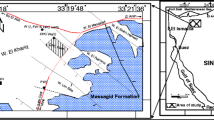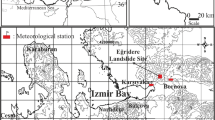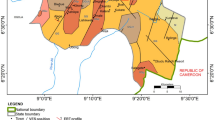Abstract
Detailed field geological, geoelectrical, hydrochemical, and microbiological studies were executed in the Wadi Hof area, southeastern Cairo, Egypt to delineate the causes of landslides along the train pathway between the eastern Wadi Hof camp and the western clay quarry. The area under consideration is of a gentle slope from east to west. The Eocene limestone rocks constitute the most common outcrops. Structurally, the investigated area was affected by faulting. Geophysically, 1D Schlumberger Vertical Electrical Soundings in addition to 2D Wenner Electrical Resistivity Tomography (ERT) techniques were performed to characterize the shallow subsurface implications. Eight Vertical Electrical Soundings were measured along with two main profiles-oriented northwest-southeast directions. A Schlumberger configuration with electrode separation starting from electrode separations (AB\2) = 1.5 m. to AB\2 = 200 m. was applied. Three 2D Electrical Resistivity Tomography profiles crossing the train pathway were constructed in a nearly east–west direction. The 1D inversion is applied using WinSev3.4 software and the 2D-ERT profiles were computed using the RES2DINV computer software. Moreover, hydrochemical and microbiological investigations in the form of water samples analysis were conducted east and west of the train pathway. The hydrochemical and microbiological characteristics of the analyzed water found that the water origin is different on the sides, east and west of the railway tracks. The integrated interpretations indicate that the study area consists of three main rock units; surface marl, calcareous sand, and, finally, clay to sandy clay units. The water originates from the Eocene limestone aquifer east of the train route directed towards the clay quarry west of the train path. Additionally, the landslides apparently result from the swelling of thick clay layers which leads to subsequent railway destruction shortly thereafter.











source of the water that caused the landslides in the study area
Similar content being viewed by others
Data availability
With respect to the data availability, the author declares that all data supporting the findings of this study are available within the article itself. The author measured by himself all the vertical electrical resistivity sounding data in addition to the horizontal resistivity profiles.
References
Abd El-Gawad AMS (2020) Water seepage source at the extension of Tourah clay quarry, southeastern Cairo based on geological and geoelectrical resistivity measurements. Earth Sci 9(3):108–116. https://doi.org/10.11648/j.earth.20200903.13
Abd El-Gawad A.M.S., and Gamal H., (2008) Application of geoelectrical measurements to detect the ground-water seepage in limestone quarry of Helwan, southeastern Cairo, Egypt. 4th International Conference on the Geology of the Tethys. Cairo Univ 141–148.
Abd El-Gawad AMS, Helaly AS, Abd El-Latif MSE (2018) Application of geoelectrical measurements for detecting the ground-water seepage in clay quarry at Helwan, southeastern Cairo. Egypt. NRIAG J Astro Geophys 7(2):377–389. https://doi.org/10.1016/j.nrjag.2018.04.003
Abdalla FA, Scheytt T (2012) Hydrochemistry of surface water and groundwater from a fractured carbonate aquifer in the Helwan area, Egypt. Indian academy of sciences. J Earth Syst Sci 121(1):109–124
Abd-Allah AMA, Dawood YH, Awad SA, Agila WA (2008) Mineralogical and chemical compositions of shallow marine clays, east of Cairo, Egypt: a geotechnical perception. J. King Abdulaziz Univ Earth Sci 20(1):141–166
Corominas J, Moya J, Ledesma A, Lloret A, Gili JA (2005) Prediction of ground displacements and velocities from groundwater level changes at the Vallcebre landslide (Eastern Pyrenees, Spain). Landslides 2:83–96
Godio A, Bottino G (2001) Electrical and electromagnetic investigation for landslide characterization, physics and chemistry of the earth, part C: solar, terrestrial and planetary. Science 26(9):705–710
Griffiths DH, Barker RD (1993) Two-dimensional resistivity imaging and modeling in areas of complex geology. J Appl Geophys 29:211–226
Henaish A, Kharbish S (2020) Linkage style of rift-associated fault arrays: insights from central cairo-suez district Egypt. Carpathian J Earth Environ Sci 15(1):189–196. https://doi.org/10.26471/cjees/2020/015/121
Huntley D, Bobrowsky P, Hendry M, Macciotta R, Elwood D, Sattler K, Best M, Chambers J, Meldrum P (2019) Application of multi-dimensional electrical resistivity tomography datasets to investigate a very slow-moving landslide near Ashcroft, British Columbia, Canada. Landslides 1:1033–1042
Loke MH (1999) Electrical imaging surveys for environmental and engineering studies: a practical guide to 2D and 3D surveys, Aarhus GeoSoftware, Skolegade 21, 1, 8000 Aarhus C, Denmark.,57 (This is a practical guide not article)
Loke, M.H., (2004) Rapid 2-D Resistivity and IP Inversion Using the Least-Squares Method. Man. Res2dinv, Version, Aarhus SPIA, Aarhus. 8000 Aarhus C, Denmark (This is also a practical guide not article)
Miller DJ, Sias J (1998) Deciphering large landslides: linking hydrological, groundwater and slope stability models through GIS. Hydrol Process 12(6):923–941
Moustafa AR, Yehia MA, Abdel TS (1985) Structural setting of the area east of Cairo, Maadi, and Helwan. Middle East Research Center, Ain Shams Univ. Earth Sci Ser 5:40–64
Perrone A, Lapenna V, Piscitelli S (2014) Electrical resistivity tomography technique for landslide investigation: a review. Earth-Sci Rev 135:65–82
Sallam E, Issawi B, Osman R (2015) Stratigraphy, facies, and depositional environments of the Paleogene sediments in Cairo-Suez district Egypt Arabian. J Geosci 8(4):1939–1964
Shan C, Bastani M, Malehmir A, Persson L, Engdahl M (2014) Integrated 2D modeling and interpretation of geophysical and geotechnical data to delineate quick clays at a landslide site in southwest Sweden. Geophysics 79(4):EN61–EN75
Uhlemann S, Chambers J, Wilkinson P, Maurer H, Merritt A, Meldrum P, Kuras O, Gunn D, Smith A, Dijkstra T (2017) Four-dimensional imaging of moisture dynamics during landslide reactivation. J Geophys Res Earth Surf 122(398–418):2
Yousif MSM (2000) Slope stability of the Middle Eocene rocks of gebel Mokattam: ICEHM, vol.47, Issue 1, Cairo University, Egypt, pp 14–32
Zohdy AAR (1989) A new method for the automatic interpretation of Schlumberger and Wenner sounding curves. Geophysics 54:245–253
Acknowledgements
Not applicable.
Funding
The research article is not funded.
Author information
Authors and Affiliations
Contributions
The research is single author “AAEG”.
Corresponding author
Additional information
Publisher's Note
Springer Nature remains neutral with regard to jurisdictional claims in published maps and institutional affiliations.
Rights and permissions
About this article
Cite this article
Abd El-Gawad, A. Landslides articulation in Wadi Hof area southeast of Cairo, Egypt, based on geological and geophysical investigations. Environ Earth Sci 80, 195 (2021). https://doi.org/10.1007/s12665-021-09478-w
Received:
Accepted:
Published:
DOI: https://doi.org/10.1007/s12665-021-09478-w




